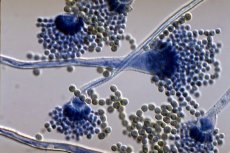Medical expert of the article
New publications
Aspergillus
Last reviewed: 04.07.2025

All iLive content is medically reviewed or fact checked to ensure as much factual accuracy as possible.
We have strict sourcing guidelines and only link to reputable media sites, academic research institutions and, whenever possible, medically peer reviewed studies. Note that the numbers in parentheses ([1], [2], etc.) are clickable links to these studies.
If you feel that any of our content is inaccurate, out-of-date, or otherwise questionable, please select it and press Ctrl + Enter.

Morphology and physiology of Aspergillus
Aspergilli are represented by septate branching mycelium. They reproduce mainly asexually, forming conidia of black, green, yellow or white color. Conidia depart from one or two rows of cells - sterigia, located on the swelling of the spore-bearing hypha. Being strict aerobes, they grow on Sabouraud, Czapek and wort agar media at 24-37 °C. After 2-4 days, white fluffy colonies with subsequent additional coloring grow on dense media,
Pathogenesis and symptoms of aspergillosis
Patients develop: invasive pulmonary aspergillosis (usually caused by A. fumigatus) with rapid growth of aspergilli and vascular thrombosis, allergic bronchopulmonary aspergillosis in the form of asthma with eosinophilia and allergic alveolitis, aspergilloma (aspergillosis asthma) - a granuloma, usually of the lungs, in the form of a ball of mycelium surrounded by a dense fibrous wall. In immunodeficiency, disseminated aspergillosis is observed with damage to the skin, central nervous system, endocardium, nasal cavity, paranasal sinuses.
Pathogenicity factors of aspergilli
The pathogenicity factors of fungi are acid phosphatase, collagenase, protease, elastase. Aspergillus toxins, such as aflatoxins, cause aflatoxicosis - food poisoning associated with the accumulation of aflatoxins A. parasiticus in food products. Aflatoxins cause liver cirrhosis and have a carcinogenic effect. Granulocytes and macrophages that digest the fungus participate in the defense against the fungus. DTH develops.
Epidemiology of aspergillosis
Aspergillus is found in soil, water, air and on rotting plants. Of the 200 studied species of aspergillus, about 20 species (A. fumigatus, A. flavus, A. niger, A. ferreus, A. nidulam, etc.) cause diseases in humans with weakened immunity. Aspergillus is transmitted by inhalation of conidia, less often by contact. They get into the lungs when working with moldy papers, dust (disease of junkmen, garbage men). Invasive methods of treatment and examination of patients (puncture, bronchoscopy, catheterization) contribute to infection.
Microbiological diagnosis of aspergillosis
The material for research is skin, nails, cornea, discharge from the sinuses, external auditory canal, sputum, pus, feces, tissue biopsies. In smears (stained with 1 frame, hematoxylin and eosin, according to Pan-Gison) septate mycelium, chains of conidia are detected. Individual lumps of sputum are transferred to a drop of alcohol with glycerin or a drop of 10% KOH and after pressing with a cover glass and copied. It is possible to cultivate the pathogen on nutrient media. It is possible to put a skin-allergy test, serological reactions (RSK, RP, ELISA, RIA), analysis for aspergillosis: antibodies to the causative agent of aspergillosis in the blood and PCR.


 [
[